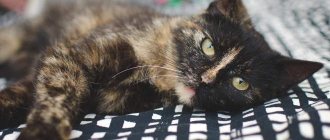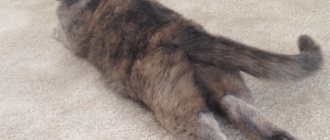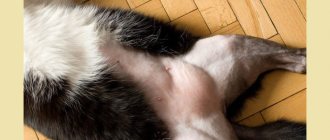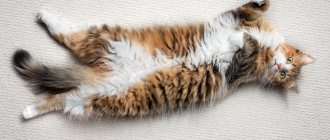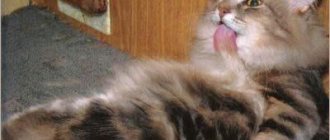Weakness in a cat's back legs is a clear sign that something is wrong. There are many reasons why this weakness can occur in the hind legs of animals and is often accompanied by other symptoms.
If you've come this far in your search for information, it's because you're concerned about your pet's health.
If so, we invite you to read the information we have compiled for you about hind leg failure in cats. In any case, always remember that a specialist’s opinion is necessary in this case. If you are concerned about your cat's health, we recommend that you take her to a veterinarian.
Dysplasia
The symptoms of this disease are not very noticeable at first.
The cat's paws seem to be tangled, it moves uncertainly, often stumbles, and limps. Over time, the animal begins to crawl. In this case, the paws clearly hurt, the animal hisses and shows aggression when trying to feel the limbs. The cause of hip dysplasia is a sedentary lifestyle, lack of vitamins and too much protein in the diet. Treatment can be extremely drastic. The animal needs joint replacement surgery. The use of corticosteroids will help delay the inevitable. If the disease was detected at a very early stage, then most often you can do without a scalpel. The animal's limbs are fixed to reduce the load and anti-inflammatory injections are prescribed, as well as supplements with glucosamine and chondroetin.
Relaxation massage technique
You need to start the massage with circular movements along the spine.
With light, pleasant movements, you need to move in a spiral, massaging only with your fingertips. First the movements go clockwise, then counterclockwise. Gradually you need to increase the intensity of the pressure, depending on the pet’s behavior. The procedure is repeated up to 4 times.
Cats, like humans, also have acupuncture points that are connected to many organs. Exposure to them activates the work of these organs and the mechanism of action of protective forces is activated. From the back of the head to the sacrum you need to apply pressure with your thumbs.
Next, you can massage the head, starting from the base of the skull. Massage is performed with light circular movements of the fingertips. Gradually the pressure increases. Stroking and pressing should be pleasant, they will make the cat relax and go limp. Now you can move on to massaging the front of the neck, but the area of the pharynx and trachea should not be touched
In those places where the lymph nodes are located, you also need to massage with caution, avoiding strong pressure
Possible causes of lethargy in healthy animals
Often there are reasons why a cat is lethargic, sleeps all the time and eats little, but it is better to understand each of them in order.
Stress
It is not uncommon for a cat to eat poorly and sleep a lot after a serious nervous shock.
Cats are very sensitive animals, so they have many causes of stress:
- travel by car;
- the arrival of a new family member or pet in the house;
- change of owner;
- repair or rearrangement of the house;
- visit to the veterinarian;
- change of place of residence by owners;
- lack of attention from the owner;
- pain;
- recent surgery;
- visit of guests;
- bathing and other hygiene procedures;
- changes in daily routine;
- the appearance of new and unusual objects in the house;
- first time on the street.
Usually cats cope with this situation quite well without medical help, but they really need the support of their beloved owner. However, in some particularly susceptible cats, stress lasts for quite a long time and can even be harmful to health.
The main physiological signs of nervous shock in a cat:
- urinary incontinence;
- rapid breathing;
- diarrhea or constipation;
- increased cleanliness (a cat can lick itself until bald spots appear on its fur and irritation on the skin);
- yawning too often;
- urinating in inappropriate places (the cat is marking its territory).
Change of feed
Often the cause of a lethargic state and refusal to eat is a change in diet (for example, switching from natural food to ready-made food and vice versa).
In this situation, you should return the cat to its previous food and treat it with some treat. Then the restoration of appetite and a cheerful state will occur very quickly.
Hot weather
Cats do not have sweat glands. They do not know how to cool themselves by opening their mouths, like dogs. Therefore, in the heat, to protect themselves from overheating, furry pets try to lie more in cool places. In addition, they begin to eat less so as not to waste energy on burning calories received with food.
Age
Over time, many owners begin to worry that their once active and nimble cat has become lethargic, eating almost nothing and lying around all the time. This is easy to explain: older cats no longer have as much energy for play; they sleep longer and more soundly than young animals.
If an elderly pet is lethargic, eats without appetite and sleeps a lot, but at the same time drinks water and has the above signs of a healthy cat, then there is no need to worry. However, an older cat should be regularly taken to the veterinarian for examinations to prevent the development of diseases.
Kittens spend almost 90% of the day sleeping until they reach two months of age. If the kitten is lethargic, plays little and eats poorly during periods of wakefulness, then the best solution is a trip to the veterinarian.
Pregnancy
In the early stages of pregnancy, many cats, like people, suffer from toxicosis. They become lethargic, try to move less and more carefully, sleep more and often refuse to feed.
If a cat was mated 3-4 weeks before this condition, then after another 5-6 weeks you can expect an addition to the cat family.
What factors cause a cat's paw temperature to drop?
The thermoregulation function is vital for all living organisms, including cats. Healthy, full-fledged animals do not need to carefully monitor the temperature of their paws. But older individuals and kittens need observation. Because their thermoregulation is weakened due to age and condition of the body. Therefore they need special care.
shutterstock
The speed of metabolic reactions in the body is the basis of thermoregulation. Moreover, if the carbohydrates that a cat absorbs with food are broken down quickly, then its body will have a higher temperature.
However, there is an exception to this natural rule:
In older cats, the rate of carbohydrate metabolism is reduced. Small kittens have a high metabolism, but it involves a small amount of carbohydrates
It is simply different in its chemical composition. You need to pay attention to hairless breed cats. After all, they do not have the ability to sufficiently control heat exchange with the environment, since there is no wool
Therefore, even in a warm house, this cat should be dressed in overalls.
If the cat is in a cool room, then, naturally, the temperature of the paws should be colder than usual. Especially if the animal starts to doze.
However, when it gets too hot, the paw pads also become cool. The fact is that cats have special glands, similar to sweat, deep between their toes, which can, if necessary, release moisture. This mechanism allows you to compensate for increased body temperature during extreme heat. Because moisture evaporates, cooling the skin. Long-haired and short-haired cats “sweat” equally. However, this phenomenon is more noticeable in individuals with short hair.
Massage for a cat during constipation
Massage for cats with constipation is important and necessary along with a modified diet.
It is necessary to monitor how the cat goes to the toilet. Bowel movements should be performed at least once a day. For older animals, emptying once every 2-3 days is acceptable, but this condition can also be called a conditional norm, since metabolic processes slow down in older animals.
With irregular bowel movements, the body may be poisoned by decay products. The impact on the heart also increases, the load on organs such as the kidneys and liver increases, and the result is problematic coat. In addition to medications, a special diet, massage for cats will be useful for constipation.
This procedure is considered very effective for constipation and is effective, after just one session, usually the animal runs to the tray within a few minutes.
Massage movements help move stool through the intestines
It is important that the pet is relaxed before starting the procedure. It’s better to put him on your lap, lightly stroking him and talking quietly
Having seen that the animal has relaxed, you can move on to massage. The abdomen is massaged with your fingertips clockwise for about 5 minutes. Starting from the chest and moving towards the anus.
If the animal begins to get nervous, the procedure should be postponed and continued when it is calm.
How to react?
All people are completely different and some of them like this procedure, while others do not. For those who like this type of massage, you just need to relax and enjoy it with your cat. For those who don't like it, you need to restrain your emotions a little and not shout at your pets. Moreover, there is no need to drive them away or beat them, because the animal came to its owner as the closest and dearest person and wants, first of all, to share a good mood with him.
If, while trampling with its paws, the cat also releases its claws, then you can simply trim them a little. However, this must be done very carefully and cut off very little to two millimeters. If you can’t do it yourself, then you need to contact a specialist. In addition, you can try to gently stroke the animal's paws. As a result, the cat will hide its claws itself. If you stroke her every time, she will get used to it over time and will not let go of them at all.
In addition, while the cat begins to extend its claws, it must be moved to its side, and it will also be forced to hide them
You can also do something to distract her attention at the moment of releasing her claws. It is worth noting that trampling your owner’s paws in any case brings both parties more pleasure than trouble.
And it doesn’t matter why the pet does this. The main thing is that this is how he shows his love
Therefore, a person should not get annoyed with his furry friend, much less shout at him.
To learn why a cat tramples you with its paws, watch the following video.
The cat's back legs suddenly stopped working, possible symptoms
If a cat's hind legs suddenly fail, the owner should do the following:
- provide the animal with complete rest;
- identify the obvious causes of the pathology (fall from height, collision with a car, etc.);
- before visiting the veterinary institution, observe the pet and find out the presence of associated clinical signs;
- When transporting an animal with injury or suspected thromboembolism, ensure immobility of the hind limbs.
In the event that a cat’s hind legs suddenly fail, a veterinarian, after examination, usually conducts an X-ray and neurological examination. If necessary, a sick cat undergoes an ultrasound examination of the abdominal cavity, an ECG of the heart, and an MRI.
If a cat under one year old falls on its hind legs due to hip dysplasia, then it is necessary to pay attention to the diet, enriching it with vitamins and minerals. Veterinarians usually prescribe supplements with glucosamine and chondroetin
The substances have a positive effect by strengthening the cartilage tissue of the joints.
To prevent your cat from losing his hind legs, you should follow these recommendations:
- Avoid injury to animals. Limiting self-walking, spaying and neutering significantly reduce the risk of trouble for pets.
- Promptly treat against parasites, including ixodid ticks.
- Follow the vaccination schedule.
- Feed your cat, especially during pregnancy, a balanced diet.
- Treat heart and kidney diseases.
- Avoid obesity in animals.
Before treatment begins, veterinarians prescribe a comprehensive treatment, since only by identifying the exact root cause can it be effectively dealt with. To identify pathology, the following examinations are performed:
- neurological examination and identification of reflex activity in the paw area;
- x-ray of the lower spine;
- Ultrasound of the abdominal organs;
- if an infectious nature is suspected - bacterial culture;
- standard urine and blood tests;
- MRI of the spine and head;
- checking the sensitivity of the limbs.
These tests are never prescribed separately. Depending on the clinical picture, the veterinarian refers the animal to several of them in order to confirm or exclude the most likely diseases. There is no time to carry out long-term diagnostics in case of limb failure.
A veterinarian explains why a cat’s back legs may fail: video
Once a specific pathology is determined, the specialist develops a treatment package. It may include the following techniques:
- Surgical intervention. This is necessary for cardiomyopathy and spinal injuries. Such operations are carried out only in a hospital, where specialists monitor the cat’s condition for several days.
- Most diseases are treated with medications in the form of injections, tablets, drops, gels, ointments, vitamins, etc.
- Sometimes it is necessary to use orthopedic devices that help simulate walking. You can make them yourself or purchase ready-made goods.
- In some cases, you cannot do without physiotherapy - acupuncture, myelostimulation, massages, etc.
- At the time of treatment, the diet is important, which the veterinarian will tell you about.
It must be remembered that when the paws fail, not only the health, but also the life of the pet depends on the speed of the animal owner’s actions, so delay in this case is unacceptable.
Symptoms of paralysis of the limbs
Symptoms of the disease appear depending on the cause of paralysis.
- With inflammation of the spine and spinal cord, weakness in the limbs occurs with possible subsequent failure. The animal may have bloating, paralysis of the rectum and bladder. The cat may begin to lick and bite its back paws. When trying to move, he feels severe pain.
- Fibrocartilaginous embolism is characterized by sudden pain. The cat exhibits apathy, there is no sensitivity in the area of the hind legs and lower back. If the animal does not react to stimuli at all, the prognosis is unfavorable.
- Arterial thromboembolism complicates the work of the heart, causing its failure. When palpating the limbs, the cat feels pain. Cyanosis is visible on the paw pads, and the limbs become cold. The animal's breathing becomes heavier and shortness of breath appears.
- Fibrosis of the heart muscle at the initial stage practically does not manifest itself in anything other than numbness of the hind limbs. Subsequently, disturbances in heart rhythm and pulse are observed.
- After a stroke, the animal will have difficulty moving, falling on its side. The ability to eat, swallow and even breathe normally is complicated. In some cases, the cat will be in a state of shock and not respond to stimuli.
With any of these diseases, you may notice the following signs in your kitten:
- the gait becomes wagging with the hind legs affected;
- the animal moves slowly and uncertainly, as if drunk;
- the hind legs move apart;
- frequent squatting on the hind legs;
- dragging the paws without lifting them off the floor.
A symptom of paralysis in cats can be dragging their paws without lifting them off the floor.
If you notice at least one of the symptoms, immediately contact a clinic or private veterinary office. Inaction or delayed treatment can cost the animal its health, and possibly its life.
For what reason did the cat's hind legs fail and what to do about it?
Sometimes pet lovers are faced with the following situation: a cat’s back legs have failed. Paralysis or paresis of the limbs is a neurological symptom of serious pathologies of the body. The list of them is very diverse and affects a variety of organs and systems. In the early stages, this condition may be reversible. Therefore, if a cat drags its paw, early contact with a veterinarian significantly increases the likelihood of recovery. One can hope that over time the animal will again feel the joy of movement. From this article you will learn what to do if your pet loses its hind legs, why this can happen and how to help your cat at home.
Symptoms of pathology
Most often, limb paralysis does not occur immediately. First, signs of motor dysfunction appear, which is why the pet does not immediately lose control of its legs, but gradually. Veterinarians recommend not to hesitate to contact the clinic if the following symptoms appear:
- The cat begins to hesitantly step on the pads. Before he steps, he tries to find his balance.
- Dragging appears when the cat is unable to move its paws: it drags them without lifting them off the floor. It seems that the pet is sneaking up on the prey during the hunt. The next stage will be paralysis of the lower or lateral part of the body.
- The cat's limbs move greatly when walking or standing.
- Constant back squatting. This often occurs in older individuals over 10 years of age.
- Severe swelling in the pelvic cavity due to bites from dogs or other cats, trauma, problems with internal organs or the lower part of the spine.
- General loss of mobility even in a young animal. The cat prefers the opportunity to lie down and relax to games.
The appearance of one or more symptoms becomes a reason to contact a veterinary hospital. Delay in consultation may result in paralysis of part of the body.
The only non-dangerous situation is a wobbling gait in small kittens. This is a natural reason, it is explained by the weakness of muscle tissue at a young age. This goes away over time and does not require therapy.
Risk factors
There are several predisposing factors that can cause poor coordination and motor activity in a cat's hind legs.
It is important to analyze them and understand what could have caused the deterioration in this case. This will facilitate diagnosis and prescribe the most appropriate treatment in a short time.
Among the common provoking factors are the following:
Getting injured. Very often, after an unsuccessful jump or fall, even from a small height, damage of varying severity can occur. Most people believe that cats can catch themselves in a split second when falling, but this is not always the case. The consequences of an injury can be visible immediately, or they can appear after a certain time, so you need to remember if similar incidents have happened recently.
- Breed predisposition
. Some cat breeds are at risk for certain diseases that can cause corresponding alarming symptoms. Hypoglycemia is considered a common problem for the Burmese breed. Chartreux and Maine Coons often have hip dysplasia, and Cymrics are considered a breed with congenital weakness in the hind legs. Such difficulties are the price to pay for artificially bred beauty and manipulation of genes carried out by breeders. - Inflammatory processes and infections
. They can affect any organ or organ system, but at different stages give complications in the form of impaired motor ability of the hind legs. In such cases, the fact that the cat walks poorly is not the only sign of illness. - Violation of metabolic processes
. Often, a deficiency of important vitamins leads to paralysis of the paws. The reason for this may be both metabolic disorders and improper nutrition of the animal.
Diagnosis and treatment of illness
In a veterinary clinic, a doctor examines a patient: palpates muscles and joints, determines sensitivity to touch, and checks reflexes. Then X-ray examinations are prescribed - the image can show the presence of fractures, dislocations, neoplasms (tumors), and joint deformities.
One type of radiography is myelography. The procedure is performed to examine the spine using contrast fluid. The test helps determine the presence of a spinal cord tumor or herniated disc. Computer or magnetic resonance imaging (CT or MRI) is considered more detailed, but also more expensive.
If the veterinarian suspects infection, inflammatory processes, or metabolic disorders, he will prescribe blood and urine tests, as well as bacterial cultures.
Once the diagnosis is made, treatment begins. It depends entirely on the disease, the symptom of which is paw failure.
Conservative methods
For diseases of the joints and cartilage, anti-inflammatory and painkillers and therapeutic physiotherapy are prescribed. Blood clots are eliminated with anticoagulants and fibrinolytic medications, but if they do not work immediately, surgery is performed.
Hip dysplasia is treated with analgesics, chondroprotectors or physiotherapy. In severe cases, surgery will have to be performed.
A course of antibiotics and supportive medications are prescribed for inflammation of the spinal cord. Vitamin deficiency and nutritional hyperparathyroidism are eliminated by adjusting the diet and using vitamin-mineral complexes. The diet is prescribed by a veterinarian, who also monitors the patient until complete recovery.
You can cope with the consequences of an encephalitis tick bite with a course of antibiotics, diuretics (diuretics), nootropic and anticonvulsants. They try to restore the affected areas of the brain with the help of neurotransmitters, antispasmodics, and restorative medications.
All medications must be used strictly in accordance with the instructions prescribed by the veterinarian! Any deviation from the prescription is fraught with complication of the condition of the mustachioed patient.
When is surgery indicated?
Basically, spinal injuries are treated with surgery, the same is suitable for removing hernias - this reduces the load on the intervertebral discs. In rare cases, conservative treatment is required. Limb injuries require surgery only in case of severe displacement or spread of fragments.
If the cause of immobility is tumors of various types, then radiation, medications and surgical intervention can help the animal.
Thromboembolism requires a quick response. If medications do not help within 6-8 hours after the blockage of the vessel, veterinarians perform surgery to remove the blood clot.
Physiotherapy
For some animals, paw mobility does not return or partially returns even after the root cause of paralysis is eliminated. Then the owner needs to apply physiotherapeutic methods - this will restore sensitivity to the paws and tone to the muscles.
Physiotherapy can be carried out in parallel with drug therapy, but first you need to coordinate this with a veterinarian so as not to harm the pet and not cause discomfort, pain, or stress.
What exercises are good:
- stroking and tickling paw pads - from 2 to 6 times a day;
- “bicycle” - carefully reproduce the pedaling of the cat’s paws;
- imitation of walking - for this, a ball or a wide strip of fabric (towel) is placed under the cat’s belly, by which the person holds the pet; The cat must thus remember the walking mechanism and try to repeat it.
Physiotherapy may also include a special massage that your veterinarian will demonstrate to you. The key to this type of treatment is patience, as results may take several weeks or even months to appear.
The cat’s hind legs are giving way, what’s wrong with her?
The nose is wet, there is an appetite, but he goes to the toilet very rarely. (In two days after the injury, he went to bed twice, but not once, his stomach was swollen.) The fur is not ruffled, it has not lost its shine. When he lies on his back or on his side he behaves actively and plays. Forgotten, he tries to get up but squeaks and falls on his side. There are no allocations. Yesterday, after trying to get up, the kitten began to tremble and after each attempt he trembled for about five minutes, but today there was no trembling all morning. My paws were shaking especially badly. There's no drooling. Now my girlfriend and I have gone to work, there is no way to stay at home with him. And my heart bleeds. I'll go and check on you during my lunch break. There are no pet specialists in our town; I don’t know who to consult. I only hope for your advice. It’s very painful to see how your dear heart suffers, and you can’t do anything to help!
Posted by Sergey on February 27, 2008, 09:54
There are two options - 1. X-ray of the spine (in two projections) and the pelvis at the same time. And subsequent long-term treatment by _specialist_2. Euthanasia (putting to sleep).
Posted by Guest on February 27, 2008, 10:13 am
But is everything really that critical?! We are not talking about euthanasia. Are there really no other options? I would agree to treatment, but I live in a town from which the regional center (where there are veterinary clinics) is more than a hundred kilometers away. I won't betray Coal! I will do everything in my power for him. Thank you for your answer, even though it is not at all happy.
Posted by Sergey on February 27, 2008, 10:18
> I would agree to treatment, but I live in a town from which to the regional center
That's what we're talking about. You don't even have the first thing you need to make a diagnosis - an x-ray. Apparently the kitten's spine is damaged. Although damage to the pelvis or hip joint cannot be ruled out. How to treat something we don’t know?
Can be maintained on painkillers and NSAIDs until profuse intestinal bleeding begins. And what will ultimately happen to what is damaged there is unknown.
Unfortunately, we are not shamans to treat over the Internet and even without diagnostic tools.
Posted by Sergey on February 27, 2008, 10:20
By the way, apparently the intestines are not controlled by the damaged nerves of the spine. And this is death from coprostasis. It’s not a fact that laxatives will help in any way.
Posted by Guest on February 27, 2008, 10:41 am
Got it. Now I’m ordering a taxi and going to Tula. By the way, can you recommend any clinics from Tula?
Posted by Sergey on February 27, 2008, 10:48
Well, how do we know about the addresses of Tula... I think there are no x-rays in state clinics. At least normal. Look for a private one.
Tell them not to prescribe NSAIDs of the first generations. Otherwise he will die from the treatment. And don’t feed him on the way, otherwise he will puke.
Posted by Sergey on February 27, 2008, 10:55
If the spine is confirmed, then at a minimum it is necessary to insist on a novocaine block with a long-acting glucocorticosteroid under the site of injury and slightly above.
And the intestines need to be dealt with.
Posted by Sergey on February 27, 2008, 10:56
Yes, and there’s also a fast-acting glucocorticosteroid.
Posted by Guest on February 28, 2008, 09:04
Yesterday, when I got into a taxi, the taxi driver asked what was wrong with the kitten. I told him. And he advised me to show it to the local veterinarian first. It turns out we have one person. True, he does not practice, but at the request of a taxi driver (a good friend) he agreed to look at my kitten. After examining, he said that everything was fine with the spine, perhaps there was a severe bruise. As for the fact that he doesn't go to the toilet well, most likely it's because of how we feed him. (He only eats raw meat with us). He advised him to diversify his food with dairy products and give him castor oil. Today the kitten slept normally. In the morning I ate sour cream (which never happened), went to the toilet in a small way, when I left for work, settled down in a big way. He sits down on his own, gets up, tries to walk, but after a few steps he lies down on his side (he doesn’t fall, he lies down on his own). Apparently he is still in pain. The doctor said that within about two weeks the kitten should return to normal. When you try to play with him, he resists and scratches with all four paws. I hope with all my heart that we get better. Many thanks to everyone who responded to our grief.
Posted by Sergey on February 28, 2008, 09:42
| Quote |
| that everything is fine with the spine |
How rich our country is in psychics. And why do they come up with all sorts of stupid x-rays?
| Quote |
| He only eats raw meat. |
Oops…
Treatment options
The method that the doctor chooses to treat the cat is directly influenced by the cause of the disease.
In case of kidney disease or a protracted treatment process that has caused the cat to have weakness in the legs, the doctor will review the drug treatment, prescribe other medications and, of course, a diet.
Hip dysplasia will require the animal to be placed in a cage for a couple of weeks to limit movement. If no results are observed, then surgical intervention is necessary.
When paw paralysis is an allergic reaction, the medications that caused it are immediately stopped and antihistamines such as diphenhydramine are prescribed.
Treatment often uses medications that relieve pain, B vitamins, as well as diuretics and antispasmodics.
But first, based on the results of general and biochemical blood tests, x-rays, urine tests and a medical examination, the real cause of what is happening must be established. Only under such conditions will the prescribed treatment be adequate and effective.
Diagnosis of the disease
Seizures in a cat: causes, what to do, treatment
To determine the cause of the pathological process, the following laboratory tests are prescribed:
- general clinical analysis of blood and urine;
- blood biochemistry;
- bacteriological culture of blood, urine, cerebrospinal fluid;
- ELISA, PCR studies to determine the virus;
- blood test for microelement and vitamin composition.
Examination by a doctor
Based on the symptoms that appear, the doctor prescribes any of these instrumental examinations;
- x-ray of bones;
- Ultrasound of the abdominal organs;
- CT, MRI to determine the structure of the brain and torso layer by layer;
- measurement of intracranial pressure;
- contrast study of blood vessels:
- Ultrasound of the heart, blood pressure measurement.
If the limbs fail and the animal is unable to stand or sit down, an X-ray is a mandatory examination.
Causes of limb failure in cats
There are many reasons for mobility impairment in cats. It is almost impossible to independently determine what the hind legs gave up. An accurate diagnosis and correct treatment can only be prescribed by a veterinarian, after conducting the necessary tests and a full examination of the cat. Failure of a cat's hind legs is a reason for urgent action.
Experts identify many reasons why a cat’s hind legs fail. The cat's movement may become impaired for the following reasons.
- Spinal injury in the lumbar region. It occurs more often in cats that roam freely on the street and may be hit by a car. There is also a high risk of such damage if the cat falls from a great height onto a hard surface. At home, spinal injury cannot be completely ruled out. With such an injury, in addition to the cat’s paws, the mobility of the tail is also impaired, since the lumbar spine, which is responsible for the mobility of the entire lower part of the body, is damaged. Possible general weakness.
- Thromboembolism. A dangerous condition that occurs due to blockage of the femoral artery by a blood clot. In such a situation, the cat experiences acute pain in the lumbar region and therefore begins to bite this place strongly. She also meows loudly due to pain. At first, the paws do not completely fail, and the cat only drags them when moving. Soon, as the tissues become necrotic, the paws become completely paralyzed and become cold. If help is not provided to the cat in the next 2 hours, then in most cases the cat dies within 2-3 days. If the pet has received the necessary therapy, then it is even possible to completely restore the mobility of the limbs. It is impossible to start treatment on your own.
- Spinal cord injury, traumatic and non-traumatic. With this disorder, the cat's paws are taken away and all sensitivity is lost. Gradually, if treatment is not started, the tissues begin to atrophy and completely lose their functions. Restoring paw mobility is not always possible, and in some cases the animal requires a stroller for normal movement. The device is attached to the animal in a special way, and the cat moves with its front paws, while the back of its body rides in a stroller. Hind legs raised.
- Tick paralysis. A very dangerous disease that leads to 100% mortality if treatment is not started within 24 hours after the first symptoms of the disease appear. Pathology occurs when a cat is bitten by ixodid ticks, which produce special substances that poison the cat’s body. At first, the animal behaves extremely excitedly. Then apathy develops and paralysis sets in, and the paws fail. The cat trembles and reacts poorly to external stimuli. There is a chance to save the cat only if you start treating it at the moment of excitement. If the paws fail, it’s too late.
- Inflammation of the spinal cord. Myelitis occurs due to infectious lesions, helminthic infestations, poisoning with heavy metal salts, injuries and autoimmune reactions. In such a situation, in addition to the fact that the paws fail, the cat experiences a general increase in temperature, urinary incontinence and digestive problems. If treatment begins immediately after the onset of symptoms of the disease, then restoring the mobility of the cat’s limbs is quite possible. In older animals, most often the restoration of mobility is not complete, but satisfactory.
- Hip dysplasia. Large, heavy animals such as Maine Coons and Chartreux cats are prone to this disease. With this pathology, a violation occurs in the development of the joint. As a result, the cat experiences severe pain when moving, which causes the pet’s gait to change. The cat walks, weaving and placing its hind legs uncertainly, and tries not to jump. If sick animals have to jump onto a bench or chair, they often fall over on their side and meow because of the acute pain that arises. Treatment is only supportive.
If problems arise with the limbs, the cat should be immediately shown to a veterinarian. The most possible diagnosis is trauma. You need to find out in detail how to treat a cat’s paws from a veterinarian. The causes of paralysis in cats are varied and the owner needs to know about the main ones.
There are many diseases that can cause loss of a cat's hind legs. There are many reasons for this, once you identify them, you can begin treatment. To do this, the veterinarian carries out laboratory and instrumental diagnostic methods and a general examination. The prescribed therapy should be strictly adhered to, and self-medication should not be resorted to, since paralysis is dangerous for the cat.
Causes
There are many reasons for problems with mobility in a cat, when its hind legs begin to move apart, fail, and even be taken away.
shutterstock
Now experts cite the following as the main factors that caused the cat to walk poorly:
- Advanced otodectosis - if the ear mite is not treated and the cat develops severe otitis media, over time the inflammation spreads to the brain, causing damage to its membranes. It leads to the appearance of various paralysis, and first of all, the hind legs lose normal mobility;
- Traumatic injuries to the spine - with this phenomenon, paralysis spreads to the hind legs and tail. The cat completely loses the ability to control the body, starting from the lower back, which causes serious disturbances not only in movement, but also in digestion;
- Lesions of the spinal cord that lead to necrosis of its tissues or severe compression of them - in this case, the cat’s hind legs are always taken away. This cause of the problem also includes cancer. Treatment at a time when paralysis has already begun is usually not effective, and the question of euthanizing the cat may be raised;
- Thromboembolism - with this disease, paralysis in the animal occurs sharply against the background of blockage of large vessels by a detached blood clot. This disease is very serious and in 95% of cases leads to the death of the animal within 36-72 hours following paralysis;
- Vitamin deficiency - when vitamin deficiency occurs in the animal’s body, all vital processes are disrupted, which changes the functioning of the ligaments and joints. In such a situation, weakness of the cat’s hind legs necessarily develops. The animal's movement is seriously impaired. The cat looks unkempt and walks, dragging its hind legs and noticeably wobbling its pelvis;
- Hip dysplasia - with this pathology, the development of the joint occurs incorrectly, due to which the muscles become significantly thinner and begin to negatively affect the hip, leading to chronic subluxation, which impairs the animal’s mobility. Often, due to the disease, the hind legs become bent, which causes the cat to move especially poorly;
- Stroke is a pathology that occurs not only in humans. The cat can also become a victim of cerebral hemorrhage. When a disease occurs, the cat receives brain damage, and if the motor center is affected, a loss of coordination of movement and mobility occurs, and first of all, the owner will notice that the cat’s hind legs have become tangled.
After the owner notices that the cat is afraid to stand on its hind legs, it is difficult for him to get up and sit down, and sometimes he even falls on his side when moving backwards, the pet must be urgently shown to a veterinarian on the day the violations are discovered. It is impossible to independently diagnose the cause of the problem and carry out high-quality therapy - only a doctor can tell you what to do and whether it is possible to cure the paws. If you delay the treatment, the animal’s condition can seriously deteriorate, which will pose a real threat to the pet’s life. Therapy must be started in a timely manner, and then the hind legs can still restore mobility, if not completely, then to a sufficient extent so that the cat does not suffer from the disorder.

